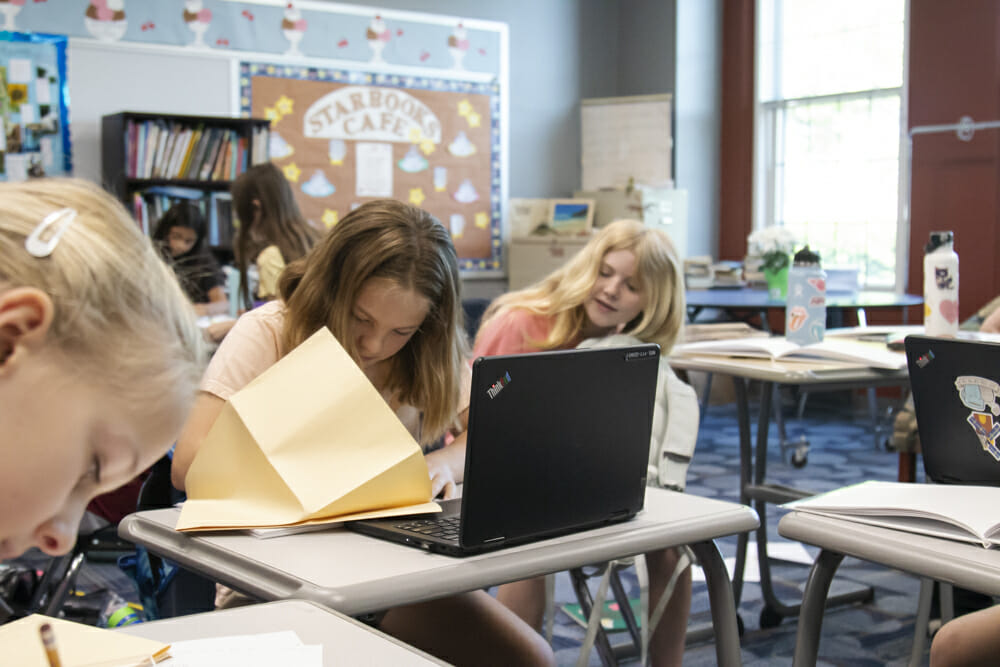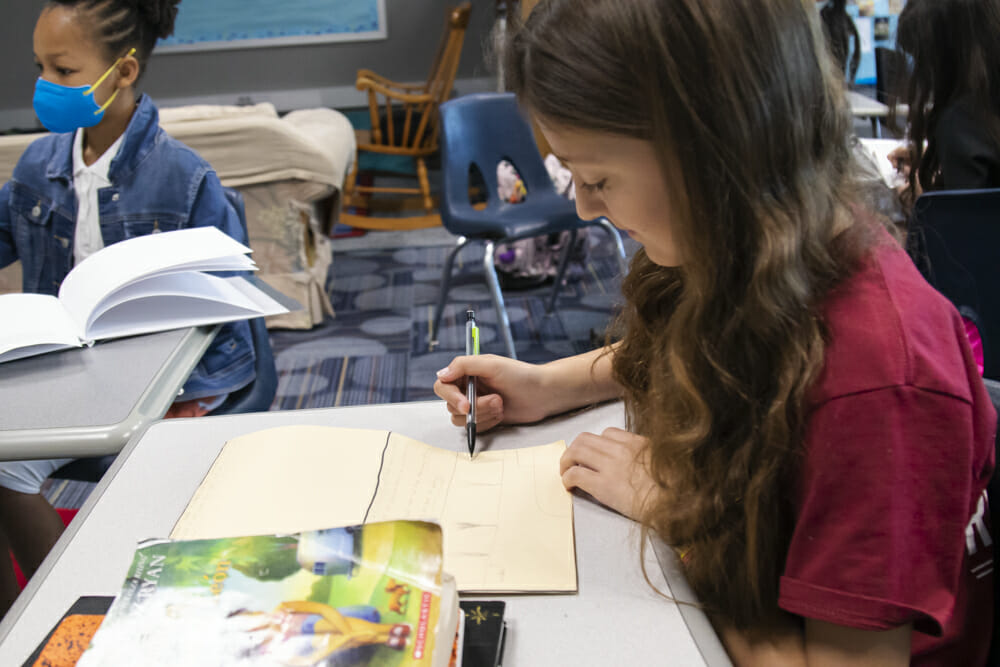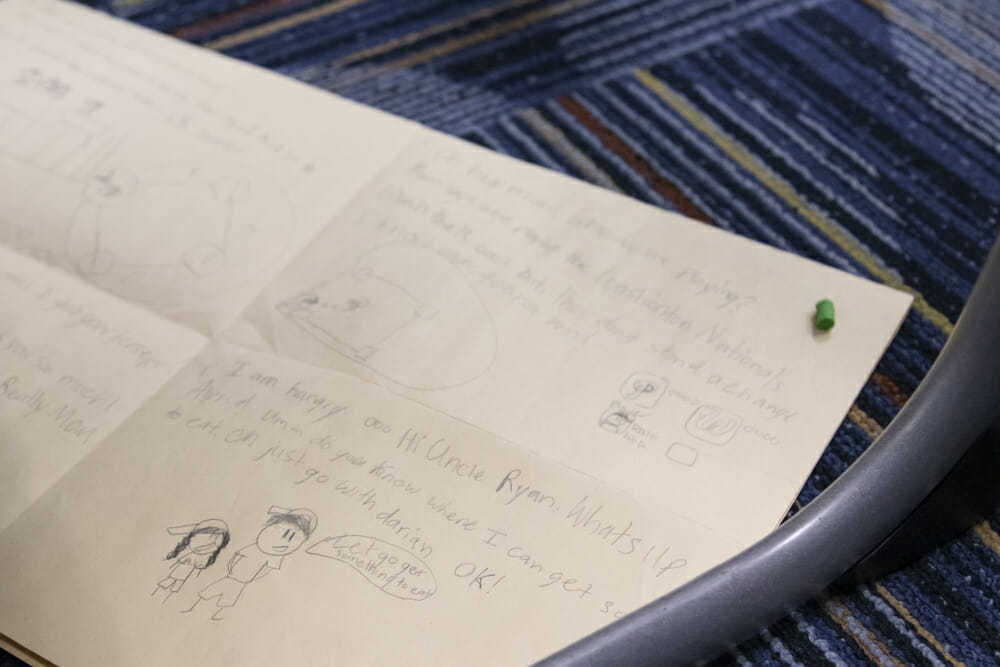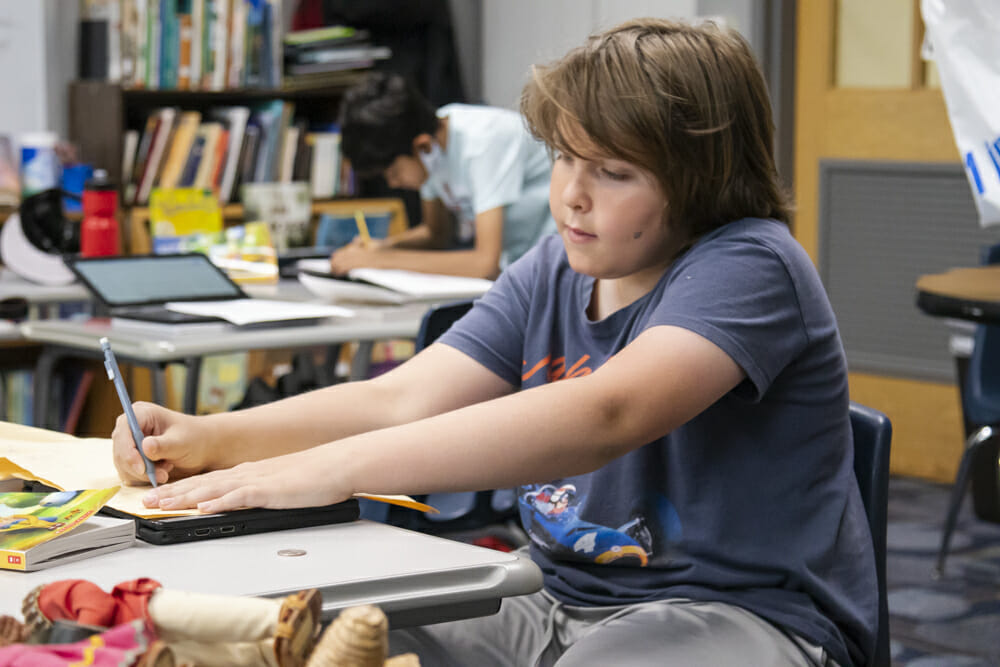What began last winter with a single word culminated in memoirs and a final bookmaking project for fifth-grade students.
With the tree ring project, students chose a word to memorialize 2021 and another one to look forward to in 2022. Then, they created rings of memories around their chosen word that would eventually form a memoir. Middle School Language Arts Teacher Kathleen Armstrong said, “Any memorable experience, large or small, happy or not, is fuel for a memoir.”
Students watched a video about memoir writing and participated in a small group writing project to jump-start the journey of becoming more acquainted with this genre. Once students embarked on their memoir-writing, they were tasked with distilling their stories into picture books for younger readers. They studied how picture books are designed and written, used large drawing paper to create a storyboard, designed illustrations that complemented the text, picked their illustration materials, and pulled it all together in a storyline.
Katherine Spekhals ’29 said, “I enjoyed being able to draw what the memoir would look like. When you write something, people make up pictures in their head, so being able to draw them was nice.” Shayaan Merchant ’29 liked telling his story and enjoyed the overall writing process. “My book is about my first adventure snow tubing, and I hope to interest younger readers with the action in the story. I loved how we learned about language arts and how to write well while being creative and figuring out ways for a younger audience to enjoy what we create.”
Armstrong expressed the importance of using the top 10 story elements for picture books:
- Character – You are the main character; this story is about you!
- Conflict – A difficult situation that you had to overcome or a problem you solved.
- Plot – How does your story flow? What are you trying to say?
- Dialogue – Conversations and action among characters make the story come alive.
- Theme – What do you want your readers to think about after the story ends?
- Pace – How do you create tension or suspense? How do you string the story out to slow down a vital action and hold interest?
- Word Choice – Use powerful verbs and strong nouns, and avoid inactive words.
- Patterns – Not needed in a memoir.
- Rhyme – Not needed in a memoir.
- Beginnings & Endings – Your opening sentence should grab the reader’s attention, and the end should hold that attention.
Armstrong further added nuance to the writing and storyboard process. She discussed creating a mood, using flashbacks, breaking up the text when the character’s location changes, and introducing secondary characters and actions like surprises, arguments, or people working together. Students learned the purpose of endpapers—the pages at the beginning and end that sometimes have designs covering the pages that relate to the story. They created design pages with small sketches of an artistic element that appears later in the book and title pages with the book title, author, and illustrator’s names. Fifth graders enjoyed pausing and reflecting on who they would dedicate the book to on the dedication page.
Emma Oesch ’29 loved that she was able to design her own illustrations, and Veronika Landrum ’29 liked that she could tell our story in a fun and creative way. Many students discovered the ease and challenge of using watercolors and figured out how to keep the paints from bleeding through to the next page or off the page’s borders. Mrinali Kaswan ’29 even learned how to paint with a cast on her arm!
Students enjoyed having total control of the story, design, text, and illustrations. Lilian Huynh ’29 said, “I enjoyed expressing the words of our memoir and changing it into a picture. I put a lot of effort into the sketching, which was time-consuming, so I used watercolors to fill it in because it was easier. It was fun to use different mediums to make the picture book.” Timo Finnegan ’29 had fun with the process. “My book is about skiing off a jump in Breckenridge,” he said. “I liked making a picture book and formatting it correctly.” Other students shared challenges in writing details and how to retell an intense story. Sam Gabrielson ’29 said, “My book is Tornado Night because I was working on a 3D printing project and had to go to the store during a tornado warning. I found it challenging at times to simplify the text and not miss any details and have the drawings fit the text.” Hayden Dembiec ’29 added, “My book was about a pretty bad paintball loss. I enjoyed writing it and how artistic it was. I was really happy with how it turned out!” Charlie Swank ’29 said, “My book was about a hockey championship I won a year ago, and it includes a timeline and a story about my team. I really liked it! It was a fun activity, and it ended up being a really cool project. And I get to keep it, too!”
Most books will go home with the students, but some will stay on campus for others to enjoy. Fun fact: Mrs. Armstrong has a collection of student-made books from over 20 years ago! Congratulations, Class of 2029, on writing your first memoirs!





































































